After a bad start we ended up with a decent sleep. It was a trade off between too hot with the windows closed, or being eaten to death by mosquitos with the open. There was also a small tribe of wasps chewing away at the wood outside the window, desperate to come in.
My sleep pattern from my Fitbit above shows the trouble getting to sleep, but once I finally settled it wasn't too bad.Once we had packed up, we headed to the start of the Romantic Road, Würzburg.
We had two problems to start the day - firstly all of our bread had shared the bag with the bananas and it all tasted very strongly of banana. I don't know if you've ever had a bread, salami, ham, cheese and banana sandwich, but I don't recommend it. Or as per our dinner tonight, a banana flavoured hotdog...
Our second issue was a bit more of a problem, and that was finding a park in Würzburg. Initially we tried to park outside a church but the big car coupled with the narrow parking places made it very difficult. Add on top of that, the constant flow of cars, cyclists and people randomly walking behind, in front or around the car and it very quickly became an exercise in frustration. When we gave up on that park, we located the Market Place underground car park. Again we struggled with narrow parks and cars that came flying around corners way faster than was safe, but eventually we snagged a park in the bottom level of the dungeon:
Our first sight of Würzburg was the market square (Marktplatz). On the side of the Market Square was the very impressive Maria Chapel (Marienkapelle), a 14th century Gothic church. The Market Square was also hosting markets selling everything from clothes and spices to garden tools.
 |
| The Midsummer Maypole |
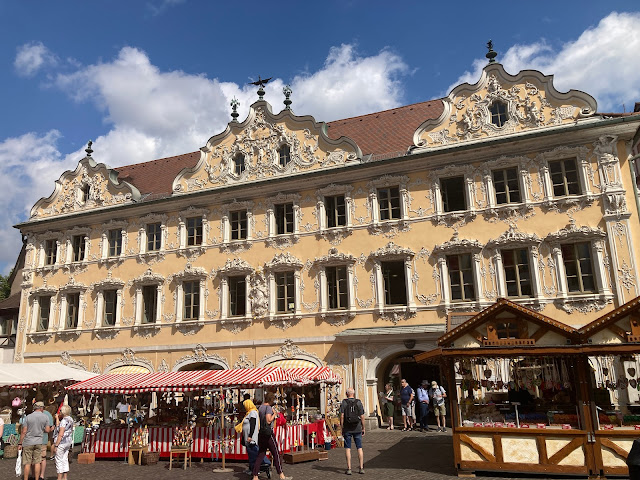 |
| Falkenhaus - A former Priest's House |
 |
| The market and the Midsummer Maypole |
 |
| Chronosbrunnen Fountain (1770) |
From the market place, we walked down to Residenz (the Residence), a UNESCO World Heritage Site, build between 1720 and 1744 to imitate the Palace of Versailles.
Like most of Würzburg, it was seriously damaged in an allied firebombing raid in 1945 and was extensively rebuilt:
 |
From the Residence, we walked towards Marienberg Fortress (Festung Marienberg) and the Old Main Bridge (Alte Mainbrücke).
The fortress was built in the 16th century and continued to be added on until the 18th. It was rebuilt as a Baroque residence after it was captured by the Swedes in 1631 and then was used in the wars through the 1700-1800s century before, before being badly damaged in the bombing in 1945.
The Old Main Bridge is the oldest of the Würzburg bridges over the river Main. Started in the 15th century it was the only crossing until 1886. It houses twelve statues of important persons:
 |
| Looking down the Main |
 |
| Pippin the Younger, King of the Franks, Father of Charlemagne |
 |
| Saint Totnan, one of the apostles of the Franks |
 |
| Saint Kilian, one of the apostles of the Franks |
 |
| Bishop Friedrich I of Utrecht, one of the patron saints of Fürstbischof Friedrich Carl von Schönborn |
 |
| The Blessed Virgin Mary represented as Patrona Franconiae |
 |
| Saint Colonate, one of the apostles of the Franks |
 |
| The bridge saint John of Nepomuk |
 |
| Saint Burkard, first Bishop of Würzburg |
 |
| Saint Charles Borromeo, one of the most important representatives of the Counter-Reformation and the second patron of the Fürstbischof Friedrich Carl von Schönborn |
 |
| The canonized Emperor Charlemagne |
 | ||
| Saint Bruno, Bishop of Würzburg and builder of the Würzburg Cathedral |
 |
| Saint Joseph depicted with a young Jesus |
 |
| Festung Marienberg (Marienberg Castle) |
Walking back through town we stopped to visit a few more sites:
 |
| St Michael's Church |
 |
| View of the castle down past the church |
 |
| Old Town Hall (Rathaus) |
 |
| Vierroehrenbrunnen (Four Tube Fountain) |
 |
| The crest of the former district of Tauberbischofsheim on the Court House |
 |
| The spire of St Martin Church (built in 1910 to replace the old church) |
 |
| Sculpture outside St Martin's Church |
 |
| Sebastianuskapelle (Sebastianus Chapel) - Built in the 15th century |
 |
| Market Square |
 |
| Schloss Tauberbischofsheim (Castle Tauberbischofsheim) |
 |
| Fountain in castle square - Tomas was annoyed that the boy had his foot in the water |
 |
| Schloss Tauberbischofsheim |
 |
| A bit of a fixer-uper? |
After Tauberbischofsheim we headed to our new apartment in Rothenberg ob de Tauber. This was the town I was most excited to see and one of the main attractions on the Romantic Road.
But first we needed to check into our accommodation, Bunter Hund (Colourful Dog) an apartment 5min walk from the walls. It was a big step up from the camp site and we got a few loads of washing done and managed to cook dinner:
 |
| Cam drew the short straw and got the kids room (because he got to pick the bed the first night, while Tomas had the couch) |
 |
| While Tomas got this room with TV, LED lights and a fan. |
 |
| Sunroom and foosball table |
The kids were exhausted, so Kristine and I left them to recover and went for a walk around Rothenberg.
The old quarter of the town was fully enclosed by city walls, with several towers. We started walking to Galgen Gate (U) which was just around the corner from our house and then down to Röder Gate (P) and from there there into the town. Our plan was to walk around the outside and finish in the market, but it was almost 6pm and most of the places were closing up, so we went straight to the market and then worked out to the castle and then around the southern walls to exit via Spital Bastion (V) and walked home from there (via the store).

V - Spital Bastion
 |
| Rothenburg ob de Tauber |
The old quarter of the town was fully enclosed by city walls, with several towers. We started walking to Galgen Gate (U) which was just around the corner from our house and then down to Röder Gate (P) and from there there into the town. Our plan was to walk around the outside and finish in the market, but it was almost 6pm and most of the places were closing up, so we went straight to the market and then worked out to the castle and then around the southern walls to exit via Spital Bastion (V) and walked home from there (via the store).
We returned to Rothenburg on the 13th with the kids and managed to check out the Christmas museum which was closed before, and a few of the sights.
I've decided the best way to capture this is to use the map above and compile my pictures from both trips rather than try to show it all as we did it.
Our first sights of the town as we drove in:
A - The Town Hall:
The Town Hall and Tower were built between 1250 and 1400. This resulted in two seperate styles / Gothic at the rear and Renaissance at the front.
B - City Councilors Tavern / Tourist Information Office
Located next to the Town Hall, the Councillor's Tavern houses the Town Clock, which dates from 1684. The astronomical clock has a date display as well as the city crest. On the hour, the hatches open, showing a famous scene where the former major Nusch was commanded by the invading Catholic Tilly, to drink a 3.25L tankard of Franconian wine in a single gulp. He succeed and thus saved the town from destruction.
C - Historical Vaults (under the Town Hall)
Under the Town Hall are dungeons housing a museum. We didn't get a chance to visit them.
D - St James' Church
The church was built in 1311-1484 and has been both Lutheran and Catholic.
E - Rothenburg Museum
The museum is built in a former convent. Unfortunately we didn't get a chance to visit it.
F - Castle Gate
The Castle Gate is all that remains of the original castle, that was located on the spit of land now occupied by the Castle Garden. The Mask on the wall was used for pouring hot tar on invaders.
G - Castle Garden
The Castle Garden was the original site of Hohenstaufen Castle, built in 1142. The castle was destroyed by an earthquake in 1356.
H - Franciscan Church
This is the oldest church in the city, which was built in 1285.
I - German Christmas Museum
This building houses a museum of Christmas decorations as well as a large store of Christmas ornaments and decorations. We felt some real parallels to Bronner's in Frankenmuth, when we visited Saginaw
J - George's Spring
George's Spring in the Market Square is the biggest spring in Rothenberg, 25' deep and holding 25,000 gallons of water. The decorations on the pillar date from 1608.
K - Meat and Dance House
This was a patrician's house where dances were held on the top floor and the bottom was a butcher's store. We saw this, but unfortunately didn't get any pictures.
L - Medieval Crime and Justice Museum
We didnt get to visit the museum as we always arrived in town too late, but we got to see the outside. We decided that this would be Cameron's bedroom for the next night (apparently it couldn't be Tomas' as his cage is in the basement.)
M - St John's Church
The church was built in 1200 and was originally the headquaters of the Hospital Order of St John. It has since been Lutheran (1553), Catholic (1803) and is now Roman Catholic.
N - Plönlein / Siebers Tower
The most famous shot of Rothenburg is of Sibers Tower and the Kobolzell Gate. Plönlein means little square and forms the area in front of the towe. The tower was built in 1385 to form part of the newer fortifications:
O - The Old Forge
Unfortunately we missed the half-timbered old forge.
P - Röder Gate and Tower
The town gate from the 14th century, with toll booth and gatekeeper's cottage.
Q - Old Rothenburg Craftman's House
Unfortunately we missed this one. It was a craftsmen's house built in 1270.
R - Röder Arch / Markus Tower
The arch and tower were build around the year 1200 with the first city wall. They were part of the first fortifications that were later replaced with the outer walls:
The White Tower was part of the original walls and then housed the Jewish Community from 1390 to 1520.
T - St Wolfgangs Church
This church was originally part of the fortifications, but unfortunately was in the northwest part of town which we didn't get to.
U - Galgen Gate (Gallows Gate)
Built in 1388, this gate originally housed the gallows, showing that Rothenburg was a free imperial city. This was one of the most commonly attacked gates and, in the Thirty Years War, Catholic generals Till and Turenne managed to invade the fortress at this gate (1631 and 1645).

There is now an adventure playground just outside the walls of the town, in the former southern moat.
There were also a few smaller towers along the way:
 |
| Women's Tower (Built 1430, likely a women's prison) |
 |
| Thomas Tower (or Shepherd's Tower) built 1340 |
V - Spital Bastion
The Spital Bastion and Spital Hall mean Hospital. The tower and building before the gate is Spital Hall and the tower and gate behind for the Spital Bastion. The bastion was built in the 17th century and has the inscription in Latin "Peace to those who enter. Farewell to those who leave."
The fortifications also contained a covered bridge:
W - Imperial Town Congress Hall
Unfortunately we missed this one as we followed the inside the wall walk instead.
X - Kobolzell Gate
This gate was built in 1360 and is one of the town's main four gates. It forms part of the most famous part of Rothenburg along with Sibers Tower (N). The photos of this are in N.
Y - Kobolzell Church and Double Bridge
These were outside the walls and we didn't get to visit them. But we did get a picture from the lookout:
Z - Toppler Castle
This was outside the walls and so we didn't get to visit it.
City Map:
Other:
Saint Mary's Pharmacy:
Located by George's Spring, the building is called the "Jagstheimerhaus" because Mayor Jagstheimerhaus built it in 1448. It became a pharmacy in 1812:
Outside St James Church there is a metal cast city map:
Just before the castle is an amazing lookout over part of the city and the forests below:









































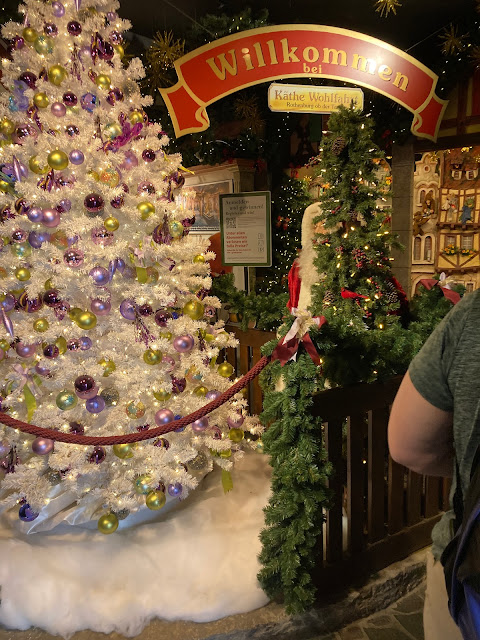































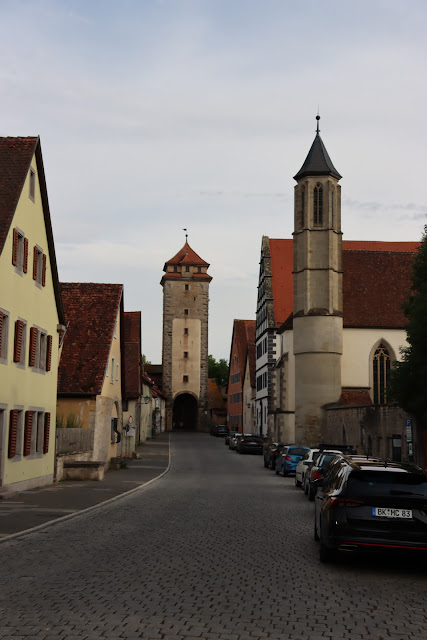

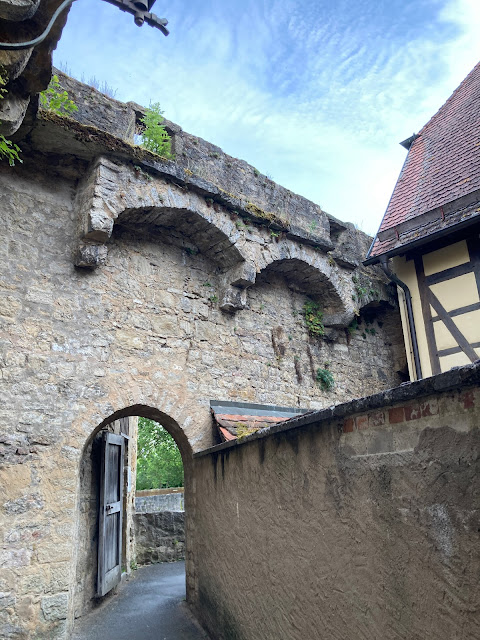
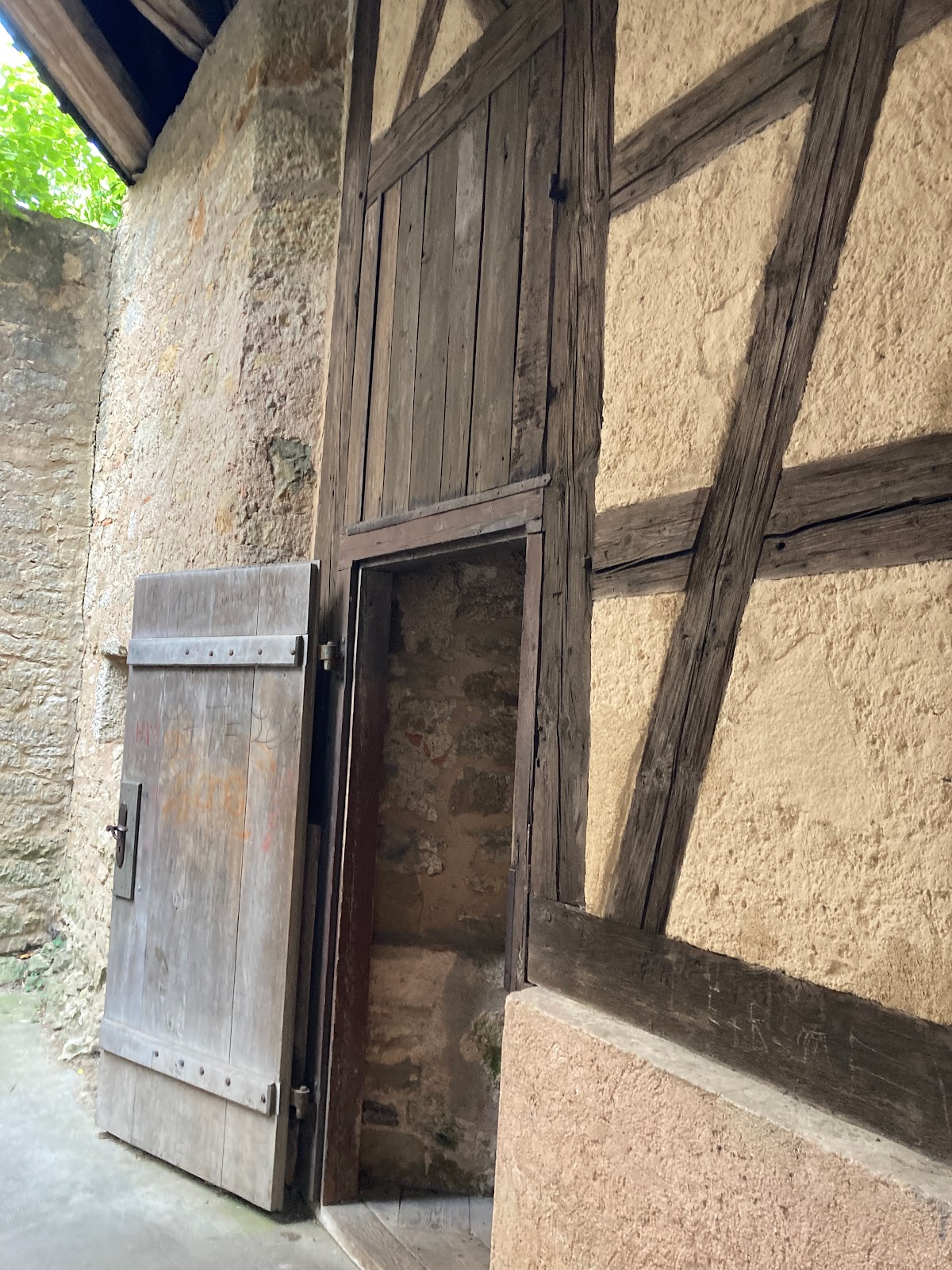















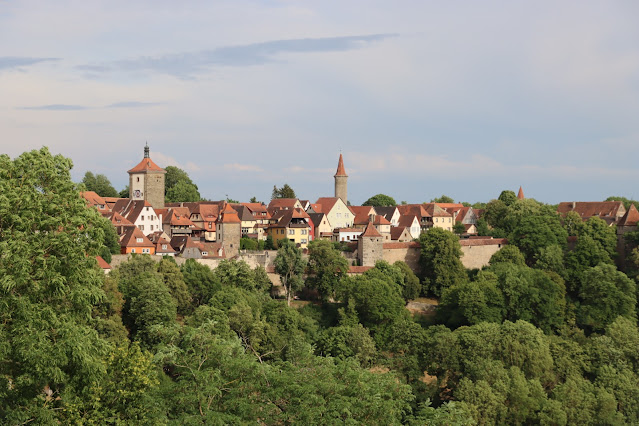


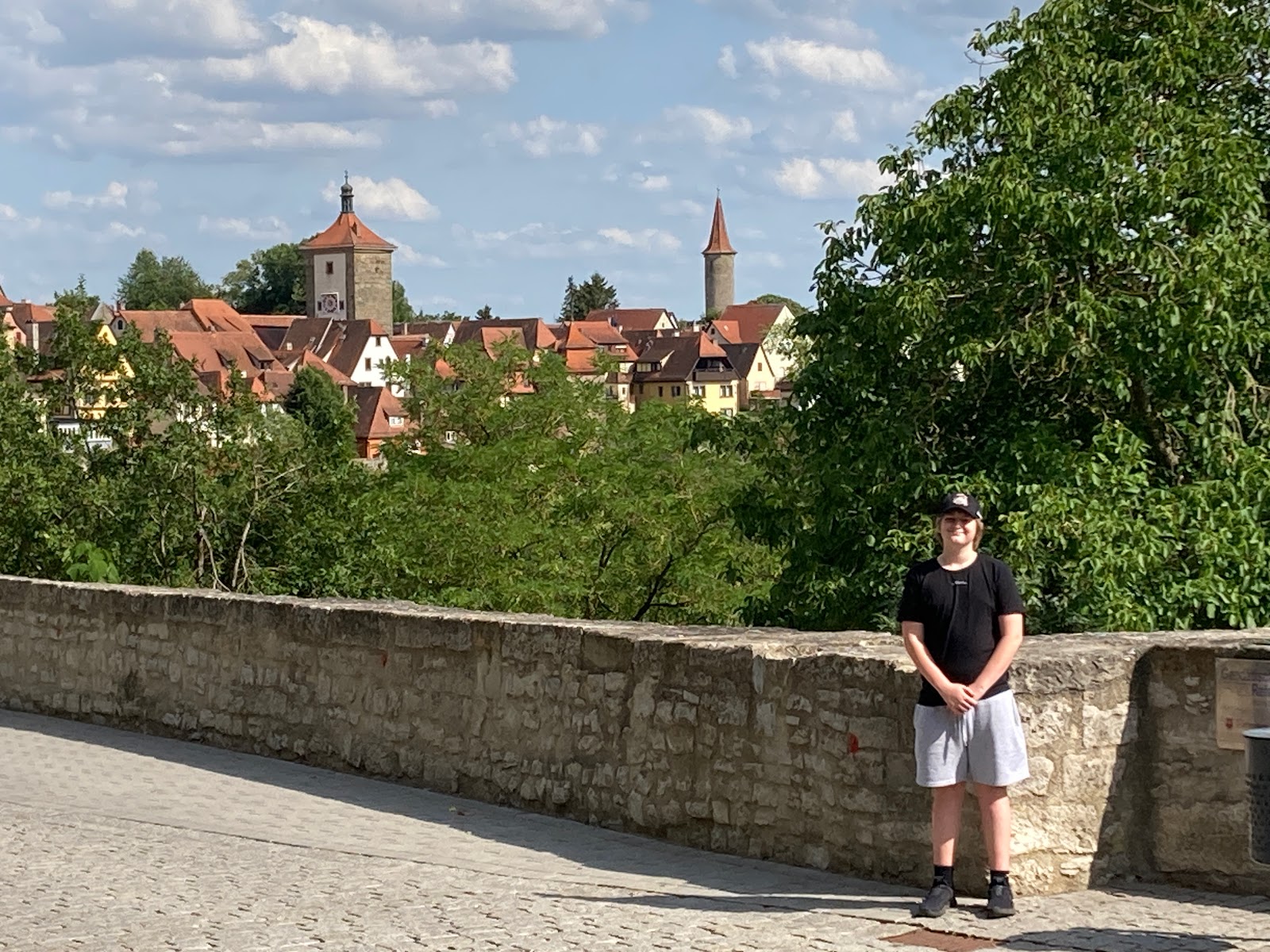


No comments:
Post a Comment